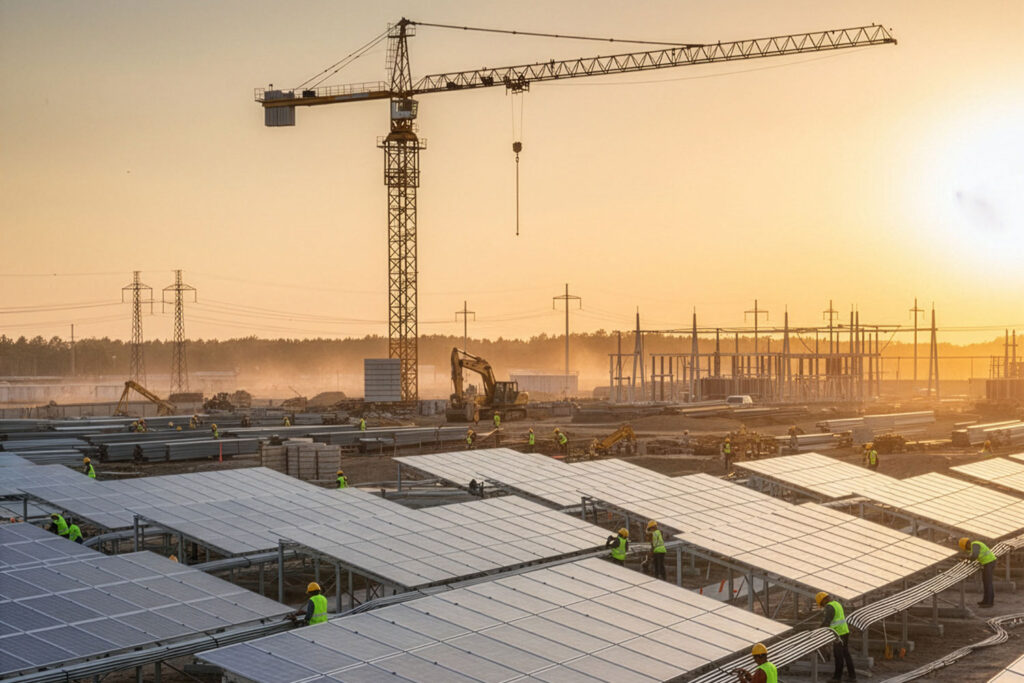
The way we power the world is changing faster than ever. Electric vehicles are everywhere. Homes are going solar. Data centers are popping up all over the country. And the construction industry is right in the middle of it all.
If you’re a contractor, it’s time to start thinking beyond just pouring concrete or running pipe. The next wave of opportunity is tied to energy – how it’s created, stored, and delivered.
Understanding the Basics: AC, DC, and Transformers
Every piece of electrical power starts with one of two types of current: alternating (AC) or direct (DC). AC is what comes through your outlets – the type of electricity that flows back and forth 60 times per second. DC is the steady, one-direction current that powers electronics, batteries, and solar systems.
Transformers are the devices that make sure the power you use is at the right level. The canisters you see hanging from power poles? Those are transformers. They “step down” the massive voltage from power lines – sometimes over 100,000 volts – to a safe 120 volts that can run your home or office.
Contractors working in commercial or industrial construction will often deal with “three-phase” systems that use 480 volts. Knowing the basics of how power gets distributed can help you communicate better with engineers, plan more efficiently, and avoid surprises during installation.
The Rise of Solar and Battery Systems
Solar technology is improving every year. Modern panels convert sunlight to power with around 20% efficiency – a big jump from just 14% a decade ago. But panels alone don’t run your home or business. You also need inverters to turn DC power from the panels into AC power you can actually use.
Battery storage systems add another layer, allowing buildings to store power for later. These systems are becoming more common not just in homes, but in schools, hospitals, and large commercial facilities.
That means more work for electricians, site prep crews, and general contractors. Whether it’s building concrete pads for solar farms or installing conduit for charging systems, the demand for skilled trades is only going up.
Electric Vehicles and Infrastructure
The push toward electric vehicles isn’t slowing down. With more EVs on the road, more charging stations are needed – at homes, offices, and especially along highways.
Installing those chargers isn’t just an electrical job. It involves trenching, concrete work, conduit installation, and in some cases, structural design for mounting systems. For contractors who can coordinate those services, this trend represents a massive new revenue stream.
Even beyond EVs, the grid itself will need upgrades to handle new loads. Many power grids in the U.S. are decades old. As demand grows, so does the need for infrastructure projects – everything from substations to underground cabling to power plant retrofits.
Data Centers: The Hidden Power Drain
Everyone’s talking about AI, cloud computing, and streaming – but few realize that data centers now consume almost one-third of America’s total electricity output. That demand is driving new construction across the country.
Data centers require huge power capacity, cooling systems, and ultra-reliable backup power. Contractors with experience in industrial electrical work, site prep, or mechanical systems are in high demand for these projects.
Why This Matters for You
Even if your company doesn’t do electrical work, the changing energy landscape still affects you. Power requirements impact scheduling, permitting, and coordination. Solar panels, batteries, and EV chargers all have physical footprints that must be planned for.
Understanding how these systems work gives you an edge when bidding jobs, managing timelines, and communicating with clients or engineers.
The Bottom Line
The construction industry is entering a new era – one where understanding energy is just as important as understanding materials or labor costs.
Contractors who learn how these technologies fit into the bigger picture will be the ones getting the most profitable jobs in the years ahead.
It’s not about becoming an electrician. It’s about staying smart, staying flexible, and being ready for the opportunities that come when the world decides to plug in.
